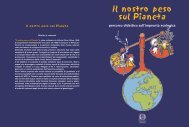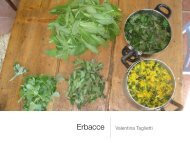Myanmar Protected Areas: Context, Current Status ... - Istituto Oikos
Myanmar Protected Areas: Context, Current Status ... - Istituto Oikos
Myanmar Protected Areas: Context, Current Status ... - Istituto Oikos
You also want an ePaper? Increase the reach of your titles
YUMPU automatically turns print PDFs into web optimized ePapers that Google loves.
Evergreen Forest<br />
Typical vegetation of the central Rakhine Yoma, these forests are located mainly in the mountainous<br />
regions of the study area, covering around 19% of the total. The dominant trees are Dipterocarpus spp.,<br />
but also examples of Swintonia floribunda (Taung Theyet), Michelia champaca (Sagawa) and Mesua<br />
ferrea (Gangaw) have been found. Some scattered deciduous trees are present, like Xylia dolabriformis,<br />
Lannea grandis and Lagerstromea speciosa. The lower storey is rich in many species, mainly evergreen<br />
and bamboos like Melocanna bambusoides (Kayin-Wa). The main threats are timber exploitation and<br />
shifting cultivation that are causing a dangerous fragmentation and encroachment of this habitat. The<br />
overall status of the remaining patches of forests seems to be still good.<br />
Sparse Semi-evergreen Forest<br />
The identification of this class turned out to be the most difficult due to the high habitat fragmentation.<br />
This situation comprises a deeply intermixed mosaic of evergreen trees and deciduous trees, as scattered<br />
big examples or small plots, and pure patches of Melocanna bambusoides, with different percentages of<br />
composition. The process that has led to the creation of this vegetation seems generally the introduction<br />
of Melocanna bambusoides in the evergreen and semi-evergreen forests, and then the establishment of<br />
this aggressive species as pure patches. Totally this class comprises about 22% of the surface.<br />
Bamboo Brakes<br />
Other typical vegetation of the area, this class covers around 15% of the study area and is dominated<br />
by Melocanna bambusoides, accompanied by scattered deciduous or evergreen individual trees. This<br />
intrusive species has been signaled since 1956 (Chein Hoe 1956) and has the potential to spread to and<br />
substitute many other forest types. As the dense growth of this bamboo precludes natural regeneration<br />
of most species, the tendency is to produce pure plots of Melocanna bambusoides. The flowering of this<br />
species occurs in mass after 30-40 years, and then they all wither and die. Other bamboo species present<br />
in the region are Dendrocalamus longispatus (Talagu Wa), Gigantochloa macrostachya (Wa Pyu Gyi) and<br />
Bambusa polymorpha.<br />
Eastern dry deciduous forest and shrubs<br />
Due to the low rainfall occurring on the eastern slopes, the vegetation is here formed entirely by<br />
deciduous species. Generally the dominant layer is close but not dense, and there is a thick understorey<br />
of bamboo (Dendrocalamus strictus or Hmyin Wa). The main trees found are Lannea grandis and Albizzia<br />
procera (Sit). The area covered by this class is around 12% of the entire study area. Close to the road<br />
many evidences of wood collection and over-exploitation have been observed, and the overall status<br />
seems to decrease heading more and more to the lowest eastern slopes where the population density<br />
is higher.<br />
Plantation and degraded dry deciduous land<br />
Moving towards the lowest slopes on the east side, the natural dry vegetation becomes highly<br />
degraded by over-logging and forest fires. Remaining scattered patches of the so called Indaing forest<br />
can be found: the main species present are Dipterocarpus obtusifolius (Inbo) and Dendrocalamus strictus.<br />
Common in the area are large plantations of Tectona grandis, established in the last 2 to 3 years, or<br />
other tree crops like cashew nuts. This class is covering around 13% of the total. Serious evidences of<br />
soil erosion, in forms of both rills and gullies, are widely present. The habitat degradation due to human<br />
over-exploitation of natural resources and modification on the natural vegetation cover is high.<br />
Eastern Agricultural <strong>Areas</strong><br />
Differences from its western counterparts come from the diverse topographic location: the valley of the<br />
Ayeyawaddy River. Due to the presence of extensive terraces of both alluvial and colluvial material, the<br />
size of the farms is usually bigger, with a more homogenous distribution. Main crops are paddy rice,<br />
both dry and irrigated, fruit trees, cotton, nuts, palms. The surface of this class is around 6% of the total.<br />
Between the fields, some remaining patches of degraded dry deciduous forest are present.<br />
DESCRIPTION OF VEGETATION COVER CHANGE<br />
AND IDENTIFICATION OF MAIN CAUSES OF CHANGE<br />
The overlapping of the land cover maps from 1974 and 2000/2003 has allowed to identify main changes<br />
in the vegetation cover of the area.<br />
The conversion from any type of natural vegetation to agriculture areas has been estimated at around<br />
173 km² on the Ayeyawaddy valley and 92 Km² on the coastal side. This is consistent with the higher<br />
rate of agricultural development possible in the lowlands close to the Ayeyawaddy River. An inverse<br />
process, still to be analysed, has been the conversion of agricultural or degraded forest areas in mixed<br />
deciduous forest: the surface involved has been estimated at 92 km². Also the conversion from Eastern<br />
Dry Deciduous Forest to Plantation & Dry Degraded Forest is an indication of the high negative human<br />
impact on the eastern slopes. This change has been noted in about 99 km². The lower rainfalls and worst<br />
soil conditions could be enhancing the degradation process, giving to the vegetation fewer chances to<br />
regenerate properly. The largest change has been identified however in the transformation from any<br />
class to the Sparse Semi-Evergreen Forest or Bamboo Brakes (Table 17), evidence of the invasion of<br />
Melocanna bambusoides in the area. More than 1,455 km² has been identified as being subject to this<br />
trend. Although the Melocanna bambusoides is found naturally in the Rakhine Yoma Elephant Range WR,<br />
it has been confirmed from this study that human practices in the area, like shifting cultivation and forest<br />
fires, are a cause of first spreading of bamboo in new areas, where later it established itself as pure patches.<br />
Vegetation class AREA<br />
(Km2)<br />
1974 2000<br />
PERCENTAGE<br />
of COVER<br />
In-depth Study of Rakhine Yoma Elephant Range Wildlife Reserve<br />
Vegetation class AREA<br />
(Km2)<br />
PERCENTAGE<br />
of COVER<br />
Bamboo brakes 455 27% Bamboo brakes 492 29%<br />
Evergreen forest 913 54% Evergreen forest 508 30%<br />
Sparse semi-evergreen<br />
forest<br />
320 19% Sparse semi-evergreen<br />
forest<br />
710 42%<br />
Table 17 Main changes occurred in the vegetation cover classes from 1974 to 2000 in Rakhine Yoma<br />
Elephant Range WR<br />
140 141






